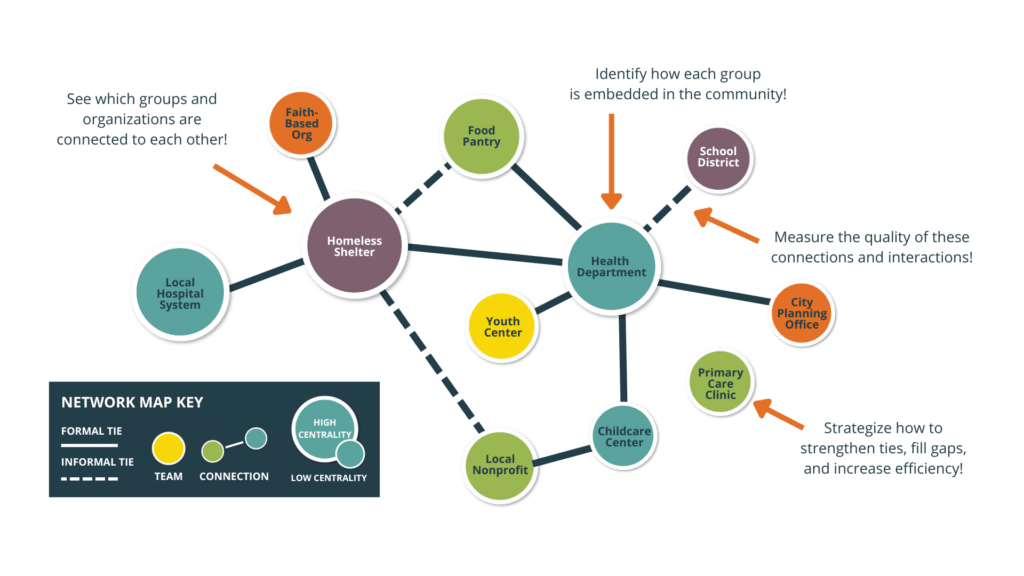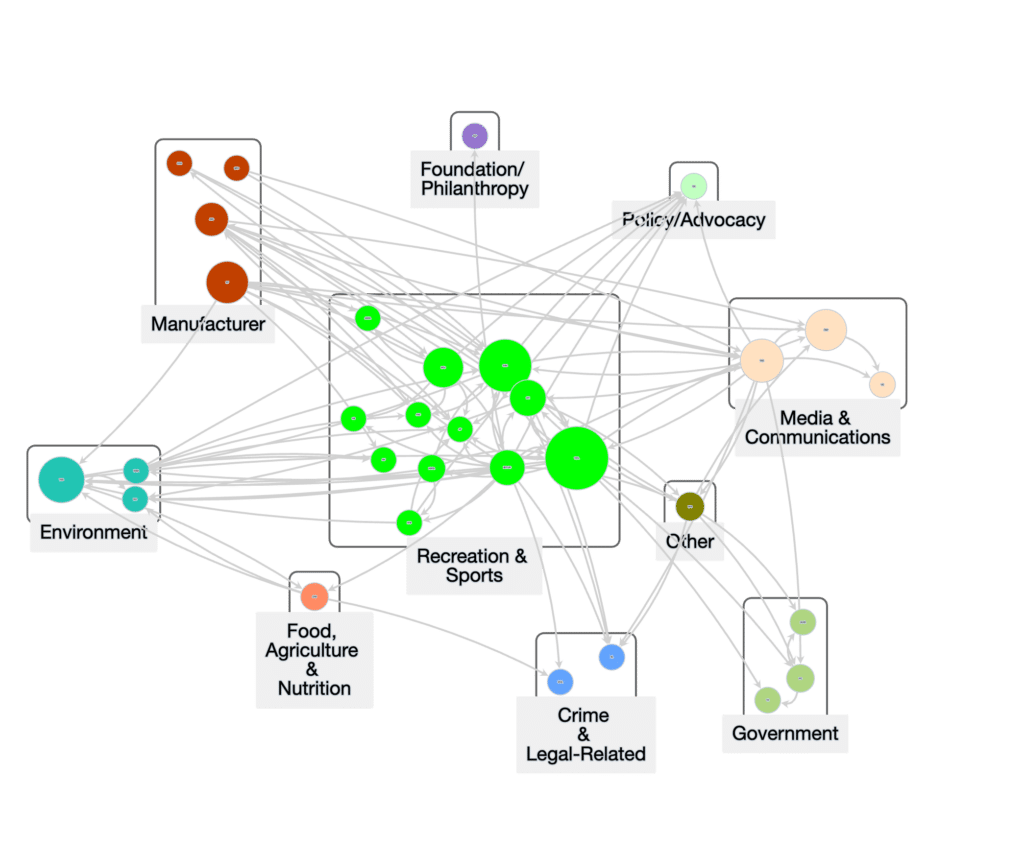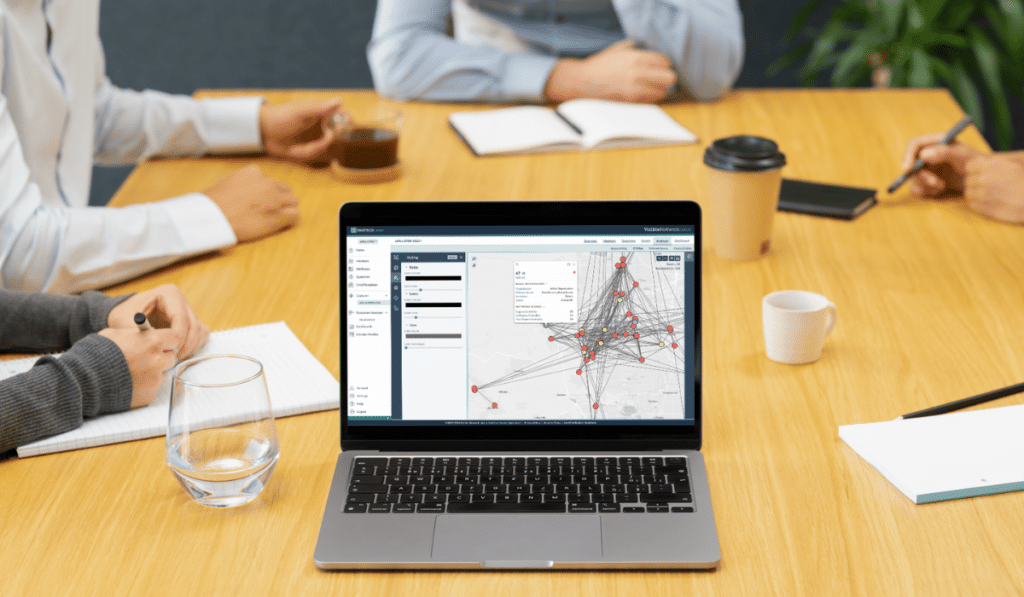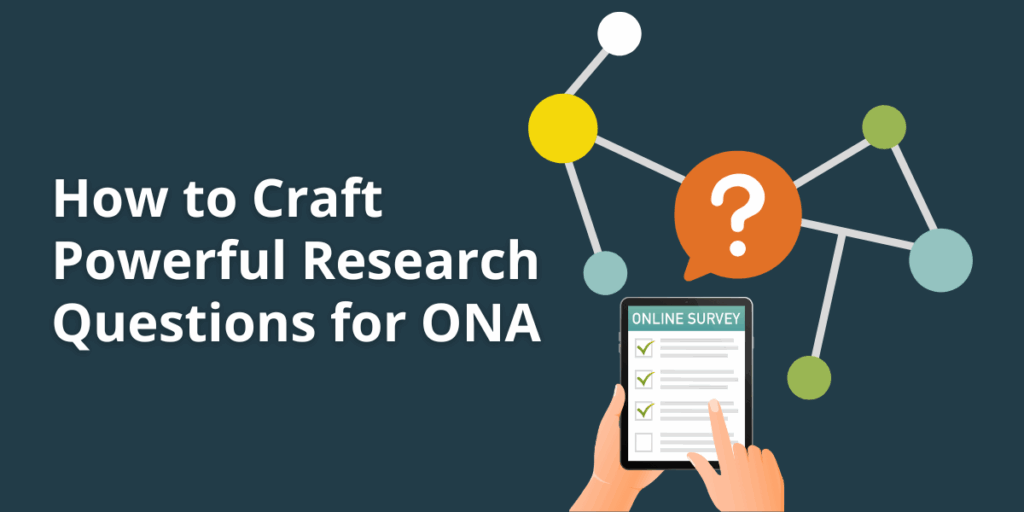Organizational Network Analysis (ONA) is a powerful methodology for studying relationships and interactions within and between organizations. The success of any ONA project hinges on well-crafted research questions that focus the analysis and ensure meaningful insights.
This guide outlines how to develop research questions that will maximize the value of your ONA, regardless of your organization’s goals or context.
Table of Contents
💡What Is Organizational Network Analysis?
ONA examines how individuals, teams, or organizations interact through relationships such as communication, collaboration, resource sharing, and trust. It uses data visualization and metrics like density, centrality, and tie strength to uncover patterns and provide actionable insights.
By answering strategic research questions, ONA can help organizations:
- Identify key influencers.
- Improve collaboration.
- Uncover structural inefficiencies.
- Enhance resource distribution.
Research questions are not just helpful; they are an essential place to start for all ONA and SNA projects.
Learn more by reading Social Network Analysis 101

Why Are Research Questions Critical for ONA?
Research questions guide the entire ONA process. They define:
- Scope: What relationships or interactions will you study?
- Focus: Which specific outcomes or improvements are you targeting?
- Approach: How will data be collected, analyzed, and interpreted?
Without clear research questions, the analysis may produce irrelevant or overwhelming results, wasting time and resources.
ONA-Specific Considerations for Research Questions
Organizational Network Analysis (ONA) focuses on relationships between organizations, which are often formal, strategic, and resource-based—not personal or casual. This means:
Relationships may form and dissolve more slowly than interpersonal or social media networks.
Questions should consider roles, responsibilities, and value exchange, not just frequency of interaction.
Unlike social media SNA, which can analyze thousands of quick, digital ties, ONA networks are smaller but higher-stakes, so every connection matters for decision-making.
Good ONA questions often explore collaboration, influence, and alignment rather than simple popularity or activity, and take into account the personal dimension of organizational relationships to ensure they are not obscuring the key elements of interest.

Steps to Develop Effective Research Questions
Here is a process to start with based on our own team’s work at VNL. You can and should customize it to fit your community’s unique needs and context.
1. Understand Your Objectives
Before formulating research questions, define your organization’s goals. Common objectives for ONA include:
- Strengthening team collaboration.
- Increasing resource sharing across departments.
- Identifying underutilized connections.
- Improving trust and engagement within a network.
For example: If your objective is enhanced inter-departmental collaboration, your question might be, “What departments are central to information sharing and where are there bottlenecks?”
2. Engage Stakeholders
Stakeholders often have unique insights into the network’s challenges and opportunities. Consult them early to ensure your questions are relevant and actionable.
Pro Tips:
- Interview key leaders and team members to understand pain points.
- Use surveys or focus groups to gather diverse perspectives.
- Incorporate feedback from all organizational levels.
Let’s say one of your stakeholders highlights poor communication between leadership and staff. This can lead to a research question like: “How does information flow from leadership to frontline employees?”

Get our monthly newsletter with resources for cross-sector collaboration, VNL recommended reading, and upcoming opportunities for engaged in the “network way of working.”
3. Define the Network Boundaries
Clearly define the scope of your network—this is called bounding the network. This process takes time to do correctly and shouldn’t be rushed through or the value of your results will be limited. Decide:
- Who: Are you analyzing individuals, teams, departments, or external partners?
- What: Will you study communication, collaboration, or another type of relationship?
- Where: Are you focusing on a single location, the entire organization, or inter-organizational connections?
4. Use the “SMART” Framework
Craft Specific, Measurable, Achievable, Relevant, and Time-bound (SMART) questions. This ensures clarity and practicality. Consider these two examples of research questions:
Non-SMART Example:
“How can we improve collaboration?” (Too vague)
SMART Example:
“What is the current level of collaboration between the IT and Marketing teams, and how can it be improved within the next 6 months?”

5. Align Questions with ONA Metrics
ONA provides quantitative and qualitative measures of network health. Tailor your questions to the metrics that will answer them effectively.
| ONA Metric | Example Research Question |
|---|---|
| Density | What percentage of possible connections are present within the network? |
| Centralization | Which individuals or teams hold the most influence in the network? |
| Tie Intensity | How strong are relationships based on trust or frequency of contact? |
| Clustering | Are there silos or subgroups that limit collaboration? |
| Trust Scores | How do network members perceive the trustworthiness of others? |
| Value Scores | What types of value do members of the network share with each other? |
| Betweenness | Where are the important brokers and bottlenecks in the network? |
| Closeness | Who are the best influencers for sharing information and ideas? |
6. Consider Network Diversity
Diversity in sectors, roles, geography, or demographics can influence network dynamics. Don’t forget about individual-level diversity, like ethnicity/race, gender, age, and education level. If diversity is a focus, design research questions that explicitly explore and measure it.
For Example:
“How diverse are the connections between teams in terms of gender, tenure, or expertise?”
“Which sectors and communities are most and least represented in the community network?”

PARTNER shows a coalition’s members grouped by sector, revealing which industries are over vs under-represented.
7. Address Practical Challenges
Design questions that reflect your organization’s capacity to collect data and implement changes. Avoid overly complex or theoretical questions that may be difficult to address.
For Example:
Challenge: Your team has limited data collection resources.
Adjusted Question: Focus on a sub-set of specific teams or departments rather than the entire organization. You can always expand or collect additional data in the future.
8. Pilot Test Your Questions
Before finalizing, validate your research questions through a pilot testing process so you don’t waste your time collecting unhelpful information.
- Sharing them with stakeholders for feedback.
- Checking if they align with your objectives and available data.
- Ensuring they are actionable and measurable.
Keep in mind your email, survey, and invitations as well. In some communities, a face-to-face invite or phone call may work better than an emailed survey link.

Get our monthly newsletter with resources for cross-sector collaboration, VNL recommended reading, and upcoming opportunities for engaged in the “network way of working.”
Common Pitfalls to Avoid
When conducting Organizational Network Analysis (ONA), avoiding these common pitfalls can make the difference between a successful, actionable analysis and one that produces irrelevant or overwhelming results.
1. Vague Questions
One of the most significant pitfalls is crafting overly broad or unclear research questions. Vague questions like “How does our organization communicate?” fail to specify what aspects of communication you are analyzing or what outcomes you aim to improve.
How to Avoid It:
- Be precise about the relationship or dynamic you are studying.
- Break larger questions into smaller, measurable components.
2. Overloading Metrics
ONA offers a variety of metrics (e.g., density, centrality, clustering) that can all provide valuable insights. However, trying to measure and analyze everything at once can dilute the focus of your study.
How to Avoid It:
- Align metrics directly with your research questions and objectives.
- Focus on the most relevant metrics for your specific goals.
- Start small and expand to additional metrics as needed.

3. Ignoring Stakeholder Input
Excluding key stakeholders during the research design process can lead to questions that don’t address real-world challenges or align with organizational priorities.
How to Avoid It:
- Engage stakeholders from the start to define objectives and scope.
- Use surveys, focus groups, or interviews to identify key challenges and opportunities within the network.
- Continuously involve stakeholders during data collection, analysis, and interpretation phases to ensure alignment.
4. Unrealistic Scope
Attempting to analyze an overly large or poorly defined network can lead to logistical challenges, incomplete data, and superficial insights.
How to Avoid It:
- Clearly define the network’s boundaries at the start.
- Ensure the scope is feasible given your resources (time, budget, data availability).
- Consider breaking down large networks into manageable subsets for more focused analysis.

20 Examples of ONA Research Questions
Each of these questions connects a specific structural network measure—like density, centrality, clustering, or reciprocity—to a functional question that matters to practitioners.
They are designed to be diagnostic and predictive, giving network managers actionable insights while remaining fully measurable and mappable with SNA methods.
This ensures your analysis is both evidence-based and directly tied to real-world decision-making.
1. Which organizations act as key brokers between otherwise disconnected sectors in our network?
Why well-crafted: Targets influence and structural holes (Burt).
SNA Analysis: Calculate betweenness centrality to identify brokers connecting clusters.
2. Are there subgroups or silos that prevent cross-sector collaboration in our coalition?
Why well-crafted: Action-oriented; informs engagement strategy.
SNA Analysis: Use clustering algorithms or modularity analysis to identify subgroups.
3. Which partners are most frequently consulted for advice or decision support?
Why well-crafted: Focuses on directional, meaningful ties (advice networks).
SNA Analysis: Build a directed network and calculate in-degree centrality.
4. How evenly distributed are relationships in the network, or is influence concentrated among a few organizations?
Why well-crafted: Reveals power dynamics; addresses equity.
SNA Analysis: Compute network centralization to quantify concentration.
5. What percentage of possible connections in the network actually exist?
Why well-crafted: Simple, baseline question on network cohesion.
SNA Analysis: Measure density to quantify overall connectedness.
6. Are new members integrating into the network or remaining isolated over time?
Why well-crafted: Temporal and actionable for onboarding strategies.
SNA Analysis: Track degree centrality changes or visualize evolving ego networks.
7. Which partners play a bridging role across geographic regions or topic areas?
Why well-crafted: Links structure to function; supports regional planning.
SNA Analysis: Combine betweenness centrality with node attributes (location/topic).
8. How frequently do organizations share resources with one another?
Why well-crafted: Goes beyond “connections” to functional collaboration.
SNA Analysis: Create a weighted network from resource-sharing ties; analyze tie strength.
9. Which organizations are most critical to keep the network connected if removed?
Why well-crafted: Informs risk management and sustainability planning.
SNA Analysis: Identify articulation points / cutpoints or use network robustness analysis.
10. Are organizations connecting primarily within their own sector or across sectors?
Why well-crafted: Explores homophily vs. cross-sector integration.
SNA Analysis: Compare assortativity scores by sector attributes.
11. Who are the most trusted organizations in the network?
Why well-crafted: Leverages qualitative perception data to guide influence strategies.
SNA Analysis: Build a trust-weighted network and calculate weighted in-degree.
12. Where are the gaps in value exchange between partners?
Why well-crafted: Directly linked to network benefit and reciprocity.
SNA Analysis: Visualize multiplex networks (value types: funding, knowledge, visibility).
13. How quickly can information travel from one part of the network to another?
Why well-crafted: Links structure to communication efficiency.
SNA Analysis: Measure average path length or network diameter.
14. Which organizations are under-utilized given their expertise or resources?
Why well-crafted: Actionable for engagement and capacity-building.
SNA Analysis: Compare node attributes (expertise) with degree centrality.
15. Do organizations perceive the network as valuable to their mission?
Why well-crafted: Captures perceived ROI of participation.
SNA Analysis: Overlay value perception scores on the network map to see patterns.
16. Are relationships reciprocal or one-directional in our information flows?
Why well-crafted: Reveals imbalances and dependency dynamics.
SNA Analysis: Examine reciprocity measures in a directed graph.
17. Is network engagement equitable across organization size or type?
Why well-crafted: Connects structure to equity and inclusion.
SNA Analysis: Use attribute-based centrality analysis to detect systemic bias.
18. How has network connectivity changed before and after a major initiative or grant?
Why well-crafted: Links interventions to measurable structural outcomes.
SNA Analysis: Perform longitudinal SNA and compare density and centralization over time.
19. Which organizations are most effective at spreading information across the network?
Why well-crafted: Ties network theory to communication efficiency.
SNA Analysis: Identify high closeness centrality nodes for rapid information diffusion.
20. Are there isolated nodes or organizations that may drop out without stronger ties?
Why well-crafted: Predictive for sustainability and retention planning.
SNA Analysis: Identify nodes with low degree and weak tie strength.

Build Your ONA Capacity with PARTNER CPRM
You can answer all of these ONA research questions and many others using PARTNER CPRM. It’s the only network science platform built specifically for inter-organizational network analysis, with tools for capturing data, mapping relationships, analyzing data, and sharing results with the community.
Request a free demo with a network science expert to see it in action and get started today.
Final Thoughts
Developing effective research questions is a foundational step in conducting Organizational Network Analysis. By aligning questions with your objectives, engaging stakeholders, and focusing on actionable metrics, you can uncover meaningful insights that drive strategic decision-making. The effort invested in this stage will pay off through clearer analysis, more impactful results, and stronger organizational networks.
Would you like help designing research questions for your specific ONA project? Contact the Team at Visible Network Labs for expert guidance and a complimentary consultation.
Frequently Asked Questions (FAQs)
Here are some common questions and concise answers about creating research questions for organizational network analysis.
Q: What makes a good research question for Organizational Network Analysis (ONA)?
A: A strong ONA research question is specific, actionable, and tied to a network concept like density, centrality, trust, or clustering. It should help you understand how your network functions or what actions you could take to improve collaboration, influence, or resource sharing.
Q: Should I start with a network metric or a real-world problem?
A: Always start with a real-world problem or decision point. For example, if your team is worried about collaboration silos, that leads naturally to questions about clustering or cross-sector connectivity. Metrics should serve the question, not drive it.
Q: How many research questions should I include in an ONA study?
A: Most successful ONA projects focus on 3–5 core research questions. Too many questions can overwhelm participants and lead to unfocused analysis. Pick the questions that directly support decisions or outcomes you care about most.
Q: What’s the difference between descriptive and actionable ONA questions?
A: The key differences include:
Descriptive questions explore what the network looks like, like “Who is connected to whom?”
Actionable questions drive decisions, like “Which organizations are isolated and need stronger connections to stay engaged?”
Actionable questions are generally more valuable for guiding interventions or strategies.
Q: Can I measure things like trust or value in a network?
A: Yes! ONA can combine structural metrics with perception-based measures. Asking participants about trustworthiness, reliability, or value received allows you to create weighted networks that go beyond “who knows who” and uncover quality and depth of relationships.






